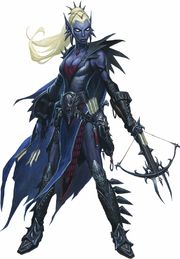Cultural Background is another element of RMU that I really like. The mechanism is really simple. There are a number of predefined backgrounds such as urban, nomad, coastal and sylvan, plus 4 others in RMU, and there is a mix of skills that are typical for people growing up in that culture. So you choose your culture and you get free skill ranks to assign into skill categories defined by your culture.
This has two immediate effects. Firstly it replaces at least in part the adolesence level for buying skills. you are just given a few ranks in some or all skill categories and regardless of the cost you just pick the skills that you want. The second effect is to force every character to have a good balance of background skills.
Avoiding Meta-Gaming?
I have a player in my face to face game that has only spent development points on weapons, magic, body development and perception and a couple of other skills that I insisted on. For hobby skills I give away 13 ranks that you can assign to secondary skills and he always tries to assign some or all of them to combat and magical skills. Compared to all the other characters he has the most hits, the biggest OB and the most magic. On the other hand he gets very upset when the challenges facing the party require tracking, lore or any of the other useful skills he eskewed in favour of big weapons.
I will confess that every now and again I take great pleasure in seperating him from he rest of the party by a wall, pit, door or whatever and give him a really simple challenge that everyone on one side of the door could easily do and he is completely perplexed by.
It is also no surprise that this player is the biggest meta gamer in the party who most of the time is using his own knowledge to decide his characters actions rather than what the chracter knows.
How Cultural Backgrounds Work
Anyway back to cultural backgrounds! Each background in my variation comprises 35 ranks spread over 13 different skill categories. The average skill costs for a single rank is about 2DP so that equates to about 50DP as an apprentice level although the single biggest block goes to languages which are traditionally cheaper.
The point of these character cultural background ranks for me is two fold. It is both faster and easier to just pick skills from a list than to try and spend exactly a fixed number of DPs. We have all been in a situation where you have to trade off one skill against another to make everything fit into your budget. Secondly it will make a Barbarian from the Frozen North significantly different from a Warrior from Chult and that difference has an impact on those characters which will last a long time into the characters careers.
Actually implementing this I have skewed everything to fit my world setting of the Forgotten Realms. If you are from Thay then you will have a significantly different skill set than if you are from Chult. On the other hand I have not really split it alone national lines. Both Waterdeep and Thay are magically very rich places and the citizens will both have a great amount of day to day experience of magic.
Cultural Background Skills Table
| Cosmopolitan
(Waterdeep) |
Coastal
(Sword Coast) |
Harsh/ Tundra/ Waste (Frozen North) |
Highland | Nomad | Rural
(Dales) |
Sylvan
(Chult) |
Underground
(Underdark) |
Urban | |
| Athletic | 1 | 3 | 2 | 2 | 1 | 1 | 1 | 1 | 1 |
| Awareness | 1 | 2 | 3 | 2 | 2 | 1 | 2 | 1 | 1 |
| Body Development | 1 | 1 | 2 | 2 | 1 | 1 | 1 | 1 | 1 |
| Combat Maneuvers | 1 | 1 | |||||||
| Communcations | 13 | 10 | 6 | 8 | 10 | 8 | 10 | 10 | 12 |
| Crafts | 5 | 6 | 4 | 5 | 5 | 7 | 5 | 6 | 7 |
| Influence | 2 | 1 | 1 | 1 | 1 | 1 | 1 | 2 | |
| Lore | 4 | 4 | 5 | 4 | 4 | 4 | 4 | 4 | 4 |
| Martial Arts | 1 | 1 | 2 | 1 | 1 | 1 | 1 | 1 | 1 |
| Outdoor | 3 | 2 | 5 | 3 | 2 | 1 | |||
| Scientific Analytic | 1 | 1 | 1 | ||||||
| Subterfuge | 1 | 1 | 1 | 2 | |||||
| Technical/Trade | 7 | 6 | 6 | 6 | 5 | 8 | 7 | 5 | 6 |
When assigning these ranks the same rule applies as with buying skills. You cannot buy ore than 2 ranks in a single skills unless the skill is listed as 1*, 2* etc., such as languages. This forces players with say 7 ranks in Technical/Trade skills to buy a range of skills.
You will notice that there are no weapon skills or armour skills in here. That means that all of your OB has to come from your 1st level development points.


